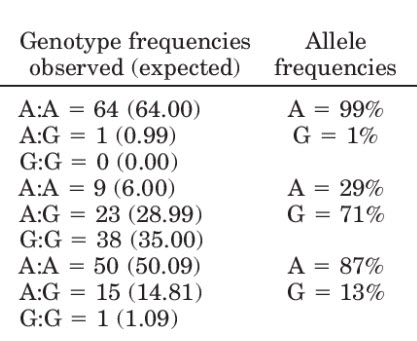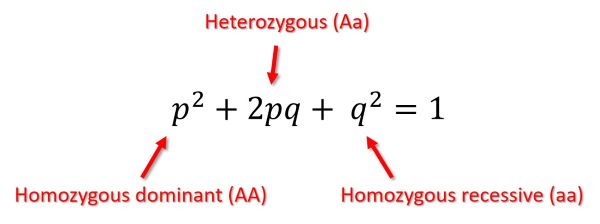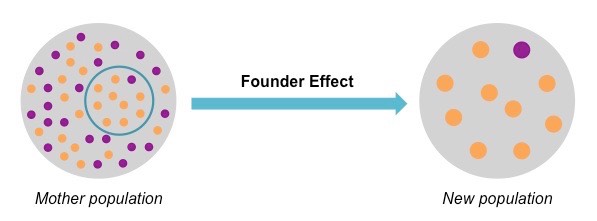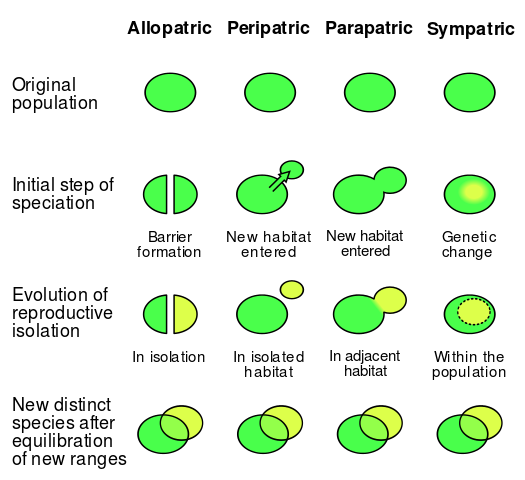Population Genetics


At the end of this session, you should have understood, and be able to describe the Hardy-Weinberg (HW) Equilibrium, factors that cause changes in allele frequencies in a population and be able to apply the HW equilibrium to real life data to determine allele and genotype frequencies. In developing this topic, we assumed that you already have a basic understanding of Molecular Genetics. You will be expected to understand the molecular basis of changes in allele or genotype frequencies. For example Mutations or natural selection for traits such as drug resistance in bacteria.
Population: A population is a group of organisms of the same species, in the same geographical space and, at the same time.
Gene Pool: Describes all the alleles and genes in a population (so same species).
Genotype frequency: is the proportion of a population with a particular genotype. It is calculated as the number of individuals with a given genotype divided by the total number of individuals in the population. Remember a genotype is made up of two alleles such as AA, Aa and aa. So the term Allele frequency refers to the frequency of each allele (A or a) in a population.

The Hardy-Weinberg principle is also known as the Hardy-Weinberg equilibrium, model, theorem, or law. The principle is named after G. H. Hardy and Wilhelm Weinberg, who first demonstrated it mathematically. The principle states that in a population that meets certain conditions (listed below), the allele and genotype frequencies remain constant from one generation to the next. The conditions that must be met include:
These conditions are seldom met but they provide a good null hypothesis. Hardy Weinberg equilibrium tests will usually test whether a population significantly deviates from these conditions. For example, small populations are generally more prone/susceptible to random envronmental impacts that have the potential to alter the allele frequencies than large populations.
To derive the Hardy-Weinberg Principle, you need a population that has all three allele combinations, so you need to cross two heterozygous individuals Aa X Aa, which results in 1AA, 2Aa and 1aa offspring.
If we represent the frequency of the dominant allele (A) as p and the frequency of the recessive allele (a) as q, Then we can say that the genotype frequency is equal to (p * p = p2) for the AA genotype, 2pq for the 2 Aa genotypes, and (q * q = q2) for the aa genotype.
As with all proportions, the total should always add up to 1, so for allele frequencies, p + q = 1, and for genotype frequencies, p2 + 2pq + q2 = 1

There is a close relationship between the genotype and the allele frequency. for example, p2 which represents the genotype frequency of the AA genotype, is derived using (p*p), which means p (allele frequency) is the square root of the genotype frequency. (This calculation obviously only works for the AA and the aa genotypes). As an example, if p2=0.64, then p = 0.8. If q2=0.04, then q = 0.2. And 2pq (the genotype frequency of the heterozygote) is [=2(0.8*0.2)] = 0.32. This can be verified to ensure the genotype frequencies add up to 1, (0.64 + 0.32 + 0.04 = 1), and the allele frequencies (p and q) also add up to 1, (0.8 + 0.2 = 1).
Changes in nucleotides in the DNA of a cell are called mutations. Although mutations are rare events, they occur in every generation of cells and organisms. Mutations may be masked (not observed phenotypically) but generally, mutations are responsible for genetic variation, so the subtle differences between individuals, especially of the same family, are partly as a result of mutations. Mutations can be good, bad or neutral. The good or bad should be perceived from an evolutionary perspective, as to whether a mutation accords an individual better chances to survive and reproduce in an environment, or not. Neutral mutations do not seem to have any impact on the evolutionary (dis)advantage of the individual that has them.
Download a pdf copy of Unit 8 - Population Genetics and Community Dynamics for offline use.
C$0.99
Gene flow can also be referred to as Allele Flow or Gene Migration. It defines the movement of genes or alleles from one population to another, as would be observed during migration. If new alleles are introduced in a population where they did not exist before, then gene flow will result in increased genetic diversity.
Mating can be described as either random or nonrandom. Random mating is an ideal situation where all individuals in a population have equal probability of mating with one another. It is also called Panmixia. Nonrandom mating is therefore the opposite, the situation where individuals do not have equal probability to mate with one another. This can be described as 'mate choice' as happens most often in humans. There are several other examples of non-random mating such as:
Inbreeding: The mating between genetically close relatives. Self-pollination in plants is the extreme type of inbreeding. Inbreeding results in a reduction in genetic diversity, which results in reduced fitness in the population, a condition called Inbreeding depression.
The opposite of inbreeding is outbreeding, which is basically mating occurring between two individuals that are genetically unrelated. In animals, cross breeding is a good example of outbreeding.
Artificial Selection occurs when a livestock breeder decides which individuals will be allowed to mate, with the intention to increase the frequency of specific alleles, and as a result specific phenotypes. When a livestock breeder only allows black bulls to mate with cows, they are indirectly selecting in favor of the alleles associated with the black coat color.
Genetic drift describes changes in allele frequency in a breeding population due to random events. Populations may also lose certain alleles due to a lack of mates, or due to chance events such as predation, environment changes and disease epidemics.
When a small group of individuals establish in a geographical area and initiate a new population. This small population is referred to as Founders. The gene pool that is formed by the founders carries a different representation of the original population's genes.

An illustration of the Founder Effect. (Source: Wikipedia, CC BY-SA 3.0)
Any event that results in a sudden reduction in population size and gene pool, such as a disease epidemic, starvation/famine, human activities, natural disasters etc. These factors cause a bottleneck. The population that survives has less genetic variation and results in offspring also with limited set of available alleles.
Some individuals are better able to survive and reproduce than others. The offspring carry the successful genes.
Genetic diversity is the total number of genetic characteristics in the genetic makeup of a species. It should be differentiated from genetic variability, which describes the tendency of genetic characteristics to vary. Genetic diversity serves as a way for populations to adapt to changing environments.
Speciation refers to the formation of a new species. A species is defined loosely as a group of individuals that can breed successfully and result in reproductively viable offspring. For this to be possible, there has to be a degree of phenotypic and genetic similarity between the individuals, a degree that allows just sufficient compatibility for the individuals to mate and their gametes to fertilize, and their offspring to survive till sexual maturity so at to be able to produce their own offspring. Research has shown that individuals within the same species share a high degree of genetic similarities within the species, but the genetic similarity reduces greatly between species. It's important to note that natural selection can occur without speciation.
Speciation can occur through five different processes
As the name suggests, instantaneous speciation occurs rapidly, usually in one generation and arises from major changes to the chromosomes, most commonly as a result of nondisjunction. Offspring from such occurrences can only produce viable offspring with individuals in the same generation but cannot reproduce viable offspring with their parent's generation.
Most speciation events happen through gradual speciation events, which are slow, gradual differences that accumulate over time. This was the type of speciation that was observed in the Galapagos finches as reported by Charles Darwin.
Geographical speciation occurs when a population is sub-divided into 2 or more smaller populations, that are physically separated from one another by physical geographical barriers such as mountains or water bodies. Over time, the species cannot reproduce within the original group.
Periodic rapid evolution (within 100-1000 generations) followed by little change over a long time suggests that population remain stable and unchanging for very long periods of time.
This model theorizes that most speciation occurs slowly at a gradual but steady/uniform rate. In this model, new species are formed and the old ones may become extinct.
Speciation may also be classified as Sympatric or Allopatric
Speciation occurs from a surviving ancestral species, while both species (new and old) continue to inhabit the same geographical region. This can be described as species whose ranges overlap.
Allopatric speciation is also referred to as geographic speciation, or the dumbbell model. It is a type of speciation that occurs when biological populations of the same species become geographically isolated from each other to an extent that prevents gene flow between them.

Types of Speciation. (Source: Wikipedia, CC BY-SA 3.0)
You can access Tensai High School Biology revision questions HERE